Table of Contents
Best Bushes for Large Gardens
Bushes are also known as shrubs and they tend to grow to a moderate height and are often more wide than they are high.
Though this isn’t always their growth pattern, just know that a bush is not a tree, and it is usually a flowering plant that often holds on to its foliage throughout the entire year. Its dense-like growth pattern makes bushes ideal to use as border plants, around foundations, and to define a pathway. Bushes are great for creating a sense of privacy between your garden and a neighbor’s yard.
Some bushes will have a very distinct look in one season, and then a totally different one the next.
Bushes tend to be versatile, hardy, and fun to grow because they can really be a wonderful addition to any garden, especially a large one that has plenty of space for them to spread out and show their full glory.
An important thing to know before deciding what bush types are right for you and your garden is to know your hardiness zone.
The United States is broken into 11 zones, with each growing zone being 10°F degrees warmer than the one before it.
Knowing your zone will help you determine which bushes will grow best for you, though this list has taken into consideration bushes that will fare best in the majority of zones in the United States.
Let’s dive in and find out which bush is best for your large garden.
1. Azalea (Rhododendrons)
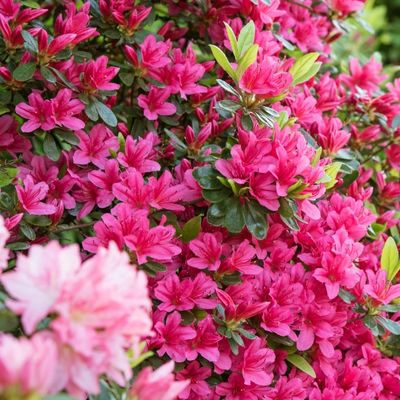
Azalea (Rhododendrons)
Azaleas are some of the most low-maintenance shrubs for any garden, and large ones are no exception.
Azaleas are known for their showy flowers that range in color from hot pinks to deep reds and a bit of everything in between.
Depending on the variety (of which there are supposedly hundreds!) an Azalea bush can be as small as 12 inches or as large as 12 feet. It’s best to begin pruning them back a bit when they reach 3 to 4 feet so their growth doesn’t get out of hand. In a large garden, you may be able to let them grow a bit longer before cutting them back.
These show-stoppers will do best in hardiness zones between 6 and 8. They can handle colder climates within reason, but will thrive best in warmer climates.
Azaleas should be planted in full sun but will tolerate late-day shade. They don’t need an excessive amount of watering, which makes them ideal for larger garden maintenance, where you may have other plants that have higher demands.
Azaleas are some of the best bushes for large gardens because of their size and the truly spectacular amount of color they will bring to your space. Even from far away, you will be able to witness and appreciate their flowers and the amount of time that they will continue to bloom.
2. Lilac (Syringa vulgaris)

Lilac (Syringa vulgaris)
Lilac bushes may not give you blooms for as long as the Azalea will, but anyone who has ever had a lilac bush can tell you – the smell of these flowers is second to none.
Though most of us think of a lilac bush as having purple flowers, there are actually a handful of different varieties. Most fall within the darker hues, such as light blue and deep purple. And though these flowers don’t stick around for long, their beauty and delicateness are hard to pass up in a garden, especially if you have room for these beauties.
Lilac bushes can be ideal for small or big spaces, depending on what variety your plant.
Though a lilac bush can vary anywhere from 3 to 30 feet, the typical lilac bush that you can purchase at most garden stores or online will usually grow to be between 10 to 12 feet.
This is an ideal size if you have ample space and room for your bush to spread out.
These perfumed plants will do best in hardiness zones between 3 and 7 which means they will do quite well in many locations and climates. Lilacs are very low maintenance and after they finish their flowering cycle can be left alone until fall, when it’s time to provide them with a thin layer of mulch to help their roots survive the winter, especially if you are in a colder climate.
Lilacs like full sun, and need at least a half-day of it, so try not to plant them near tall trees or buildings that will block them from sunlight. They also need humus-rich, well-drained soil, or they won’t bloom well.
3. Pink Flowering Almond (Prunus glandulosa)
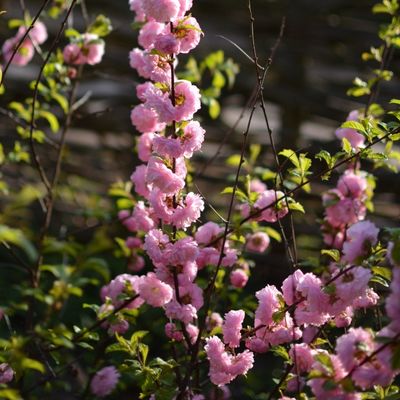
Pink Flowering Almond (Prunus glandulosa)
The Pink Flowering Almond gets a bit of a tough reputation because it doesn't bloom as long as some of the other bushes on my list do. It will bloom in early spring, even before its leaves are completely formed and its blooms won’t last much past April or May, depending on what zone you live in.
That being said, the Pink Flowering Almond still deserves a spot on this list because – even though its blooming seasons isn’t long, it is magnificent. Gorgeous pale pink flowers will adorn its branches and are delicate and dense, reminding some fans of light pink clouds or cotton candy.
Pink Flowering Almond bushes grow in a shape that many refer to as vase-like, as it becomes wider the larger it becomes. If space allows, these beauties can be used in large gardens where they have ample room to spread out, as they can grow to be as tall as 12 feet and have a span similar to that.
Because these plants can handle colder weather, they can tolerate hardiness zones as low as 4, though if you plant them in climates that cool, make sure they get plenty of sun.
In the higher zones, this is an ideal shrub to plant in areas where you only have partial sun throughout the day. Despite their large growth, they don’t require full sun the way some other bushes do.
Pink Flowering Almonds are not as picky about sunlight, but they do require well-drained soil in order to bloom and leaf out in the spring.
This bush is also a big attractor of birds and butterflies, especially early in the season, when other bushes and plants haven’t flowered yet.
If you want a big bang for your big garden early in the season, consider the Pink Flowering Almond as an option, especially if you want to attract pollinators to your yard.
4. Oakleaf Hydrangea (Hydrangea quercifolia)
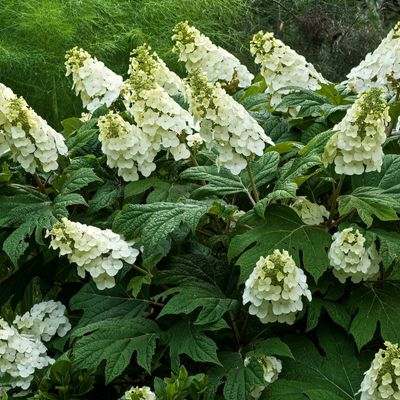
Oakleaf Hydrangea (Hydrangea quercifolia)
Another bush that is great for big gardens is an all-time favorite, the Oakleaf Hydrangea.
The Oakleaf Hydrangea is a great addition to any large garden, for not only does it have big, bold clusters of flowers, but its stems are thick and hardy, almost giving it a small tree-like appearance – thus the reason it was dubbed the “oakleaf” bush.
This bush begins to flower in early summer, producing those large flower heads I mentioned before. And, another benefit to the Oakleaf Hydrangea is that even after new blooms stop coming, the old ones will stay on the plant for a significantly longer period of time than many of your flowering bushes, allowing you to enjoy its glory for longer than normal.
Not only will it continue to bloom throughout the hottest days of the year, but the Oakleaf Hydrangea is also well-loved for its impressive fall foliage, as its flowers die off and its large, oak-like leaves begin to turn magnificent shades of red and orange.
Once the months cool and winter creeps in, the leaves fall off and the bark begins to peel, giving another show all of its own.
Oakleaf Hydrangeas can grow up to 10 feet and have a spread of a similar size. These plants will oftentimes need a decent pruning in order to keep them in a dedicated space.
This is one reason why the Oakleaf Hydrangea will do exceptionally well in a large garden. They flourish best when they are allowed to fan out.
The Oakleaf Hydrangea will do well in hardiness zones 5 to 9. These buses require very little feeding, but you will want to be cognizant of mulching their roots in the winter, especially in the lower zones.
5. Crepe Myrtle (Lagerstroemia indica)
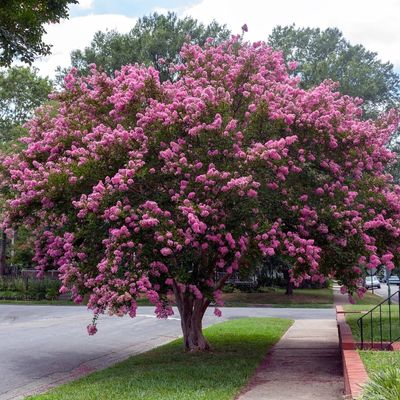
Crepe Myrtle (Lagerstroemia indica)
A favorite amongst many gardeners, especially those who want a bush that has impressive height is the Crepe Myrtle.
This fiery beauty has some of the most profound blooms of the season, and it’s what gives the Crepe Myrtle its reputation for being one of the best bushes for large gardens.
The Crepe Myrtle is known for having blooms that last anywhere from 60 to 90 days in the summer.
The flowers themselves are a bit like crepe paper, thus awarding it the name, and the blooms can be anywhere from a dark purple to reds and whites. Honestly, you can’t find a bush with better color options.
Crepe Myrtles will grow to a height of 10 to 20 feet, giving some people the impression they are actually small trees, not bushes. But this is not the case.
After they finish blooming in the spring, most gardeners decide to prune them back in the fall – sometimes quite aggressively, depending on their age.
Crepe Myrtles can definitely get out of hand with their growth, if not tended to appropriately. But this is also a reason they make the list for best bushes in large gardens. These plants are not going to be small.
If you live within the hardiness zones of 7 to 10, you will find that Crepe Myrtle’s can provide all your large garden needs.
But they can be particular. Full sun is a big factor in their success, as is well-drained, sandy soil.
Crepe Myrtles will provide you with an excellent bush for your large garden, but make sure you have lots of sun, space for them to grow high, and time in the fall to prune them back.
6. Rose of Sharon (Hibiscus syriacus)
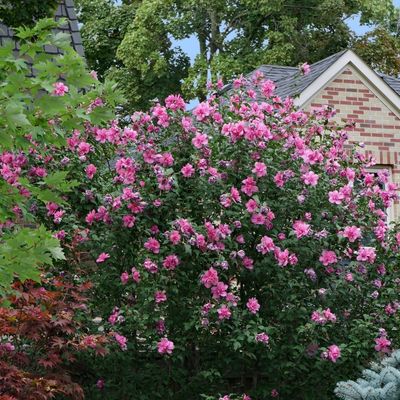
Rose of Sharon (Hibiscus syriacus)
The Rose of Sharon bush deserves a special shout-out for larger gardens. These fabulous foliagers are perfect for anyone who has some significant space, the right climate, and is ready to let their plant run wild.
While it blooms in the summer and fall, the Rose of Sharon does little the other two seasons, and actually goes fairly dormant.
For this reason, the Rose of Sharon may not be the best bush if you are seeking privacy during the colder months or want to use a bush as a way to cover or block something unsightly on your property.
If you do decide to plant Rose of Sharon bushes, you won’t be disappointed when it comes to the show they give.
They also have a height that allows for them to be planted in large gardens and provide some adequate privacy or hedging, especially along fences. They will climb up a fence, if adequately staked and cared for.
A Rose of Sharon bush can reach to heights of 8 to 10 feet, but most gardeners like to keep them trimmed back some, so they will spread out more than grow tall.
These bushes come in so many colors that it is hard to list them all. But, you will have no problem choosing one that goes well in your large garden and compliments your other plants as well.
The Rose of Sharon does well in hardiness zones between 5 and 8. Because these bushes are more heat-tolerant and are sun worshippers, you should only purchase and plant them if you know you can give them the appropriate amount of light and relatively warm climate.
7. Forsythia (Fearsithe)
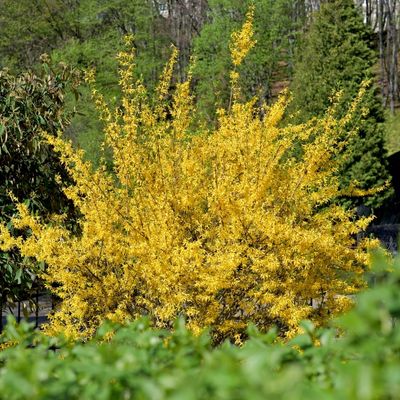
Forsythia (Fearsithe)
Another bush that is best for large gardens is the Forsythia, known for the beauty it will bring to your landscaping in early spring.
The vibrant yellow flowers that grace this bush (and will grace your garden!) are some of the first to bloom, making it an ideal plant if you want to add some bright color to your yard before everything else is ready to show their true colors.
The Forsythia is relatively easy to care for, but will require at least six hours of sun each day during its blooming period in order to adequately flower the way it’s designed to.
Though it’s known to be a tough bush when it comes to the elements (thus the reason it can bloom so early) it is best to plant this beauty if you live in hardiness zones between 5 and 8.
In colder climates (zones 5 and 6) the Forsythia can sometimes look a bit scraggly by winter’s end. If you are in one of these areas, you’ll be happiest with this bush if you do some pruning and fertilizing in the fall, in order to help it keep its dense shape intact.
Forsythias tend to grow to a size of between 3 and 8 feet tall, which is substantially smaller than some of the other bushes on my list. But, their smaller size means they also make for great shrubs to use as great border plants, or to mark paths where you need some definition, but don’t want a bush that can become overbearing with age.
Plant your Forsythia bushes in well-drained soil, with a decent amount of direct sunlight, and they will serve as the perfect spring showstopper for your large garden space.
Recent Articles

















